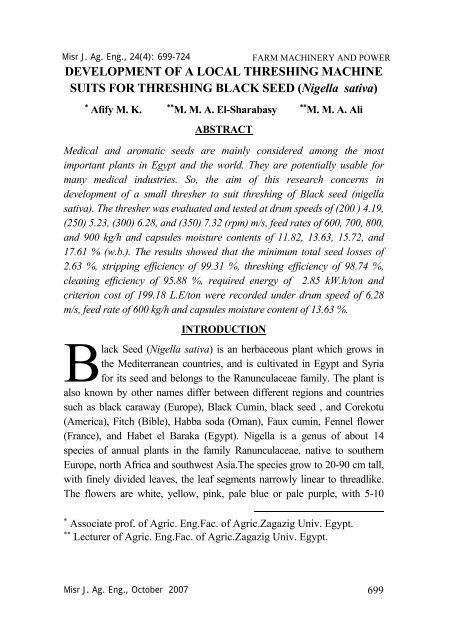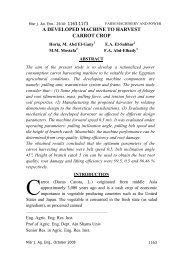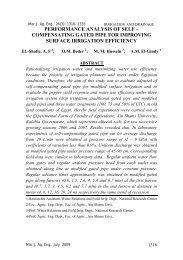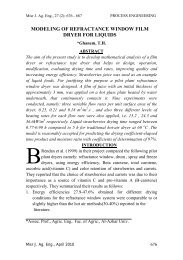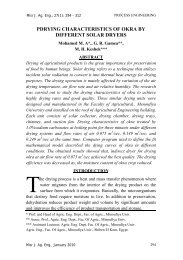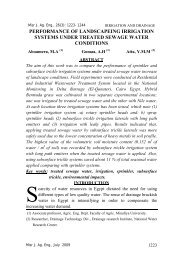Full Text - Misr Journal Of Agricultural Engineering (MJAE)
Full Text - Misr Journal Of Agricultural Engineering (MJAE)
Full Text - Misr Journal Of Agricultural Engineering (MJAE)
You also want an ePaper? Increase the reach of your titles
YUMPU automatically turns print PDFs into web optimized ePapers that Google loves.
<strong>Misr</strong> J. Ag. Eng., 24(4): 699-724DEVELOPMENT OF A LOCAL THRESHING MACHINESUITS FOR THRESHING BLACK SEED (Nigella sativa) Afify M. K. M. M. A. El-SharabasyABSTRACTFARM MACHINERY AND POWER M. M. A. AliMedical and aromatic seeds are mainly considered among the mostimportant plants in Egypt and the world. They are potentially usable formany medical industries. So, the aim of this research concerns indevelopment of a small thresher to suit threshing of Black seed (nigellasativa). The thresher was evaluated and tested at drum speeds of (200 ) 4.19,(250) 5.23, (300) 6.28, and (350) 7.32 (rpm) m/s, feed rates of 600, 700, 800,and 900 kg/h and capsules moisture contents of 11.82, 13.63, 15.72, and17.61 % (w.b.). The results showed that the minimum total seed losses of2.63 %, stripping efficiency of 99.31 %, threshing efficiency of 98.74 %,cleaning efficiency of 95.88 %, required energy of 2.85 kW.h/ton andcriterion cost of 199.18 L.E/ton were recorded under drum speed of 6.28m/s, feed rate of 600 kg/h and capsules moisture content of 13.63 %.INTRODUCTIONBlack Seed (Nigella sativa) is an herbaceous plant which grows inthe Mediterranean countries, and is cultivated in Egypt and Syriafor its seed and belongs to the Ranunculaceae family. The plant isalso known by other names differ between different regions and countriessuch as black caraway (Europe), Black Cumin, black seed , and Corekotu(America), Fitch (Bible), Habba soda (Oman), Faux cumin, Fennel flower(France), and Habet el Baraka (Egypt). Nigella is a genus of about 14species of annual plants in the family Ranunculaceae, native to southernEurope, north Africa and southwest Asia.The species grow to 20-90 cm tall,with finely divided leaves, the leaf segments narrowly linear to threadlike.The flowers are white, yellow, pink, pale blue or pale purple, with 5-10 Associate prof. of Agric. Eng.Fac. of Agric.Zagazig Univ. Egypt. Lecturer of Agric. Eng.Fac. of Agric.Zagazig Univ. Egypt.<strong>Misr</strong> J. Ag. Eng., October 2007 699
petals. The fruit is a capsule composed of several united follicles, eachcontaining numerous seeds.Paulsen et al. (1980) indicated that the moisture content of grain is one ofthe major physical factors for the design and operation of the threshingmachine that affect the mechanical damage to grains and the threshingefficiency of machines. The effect of moisture content on hardness andstrength of several grains indicates that greater energy is required to breakgrains having higher moisture content by impact compared to those havinglower moisture content. Huynh et al. (1982) stated that the seed separationfrom stalks and passage of seed through the concave gate is a function ofsome variables such as feed rate, threshing speed, concave length, cylinderdiameter and concave clearance. These variables are also related to thethreshing losses and seed separation efficiency. Kaul and Egbo (1985)stated that an optimum speed is desirable to get an optimum performance ofa thresher as excessive speed can cause the grain to crack, and too low aspeed can give unthreshed heads. Gol and Nada (1991) concluded that theimportant factors affecting the efficiency of mechanical pod strippingelement are operation speed and crop conditions. Percentage of strippingpods increased by increasing of peripheral drum speed which ranged from(473 rpm) 0.1m/s to (675 rpm) 3 m/s. Ajayi (1991) found that the moisturecontent of the crop influenced the material capacity of a locust bean thresher.Threshing effectiveness was also found to be affected by the cylinder speed.El-Behairy et al. (1997) found that the feeding rate increasing linearly byincreasing drum speed. Also feeding rate depends on the experience of thethresher labour. The straw sizes decreased by increasing drum speed whilethe grain losses decreased. Afify (1998) fabricated and constructed a simpleflax thresher to remove the capsules with minimum stalk damage. He usedthree drum shapes (peg-teeth, beaters, and peg-teeth with beaters). Theresults showed that the drum with beaters recorded threshing efficiency of96.52 %, separation efficiency of 98.21 %, cleaning efficiency of 95.79 %,stripping efficiency of 99.35 %, threshing capacity of 1.01 t/h, energy, 2.79kW.h/ton and less criterion cost of 10.29 L.E / ton under the conditions ofdrum speed of 5.23 m/s and capsules moisture content of 14.20 %. El-Hadad (2000) stated that the threshing efficiency increased with increasingdrum speed and decreasing feed rate. The maximum threshing efficiency<strong>Misr</strong> J. Ag. Eng., October 2007 700
3- Three special knifes made of stainless steel with 150 mm in diameterwere fixed as shown in Fig.(3) in the initial half on the concave at distanceof 100 mm between them starting from the entrance to the middle of theconcave. The action of these knifes interacted between the actions of beatersto help in cut the crop materials easily, reduce the impact force by thebeaters and prevent the accumulation and rotation the straw around the drum.B- The development of cleaning system:The threshed capsules fall on the sieve as shown in Fig. (3), the air blast ofthe blower push the straw out of the machine and the seed fall on theslippage surface to the seed discharge duct. The slope angle of sieve towardthe horizontal plane was equal 5˚. The sieves specifications were selectedaccording to the maximum dimension for the seed (length) as follows;diameter of sieve hole was 3.5 mm, total area of sieve holes was 0.99 per 1m 2 and the distance between two neighboring holes is 1.29 mm. (Ebiad,2005).● DESIGN CALCULATIONS:1- Threshing Drum:The principal parameters of the threshing drum are the drum length, thedrum diameter, number of beaters on the drum and the drum speed. (Soja etal. 2004). The drum length was obtained from the following equation asreported by (Kepner et al. 1978 and Resnikov, 1991).q = q o . L . M…………………………. (7)Where:L = Drum length (m), q = Feed rate of thresher (kg/s), q o = Permissible feedrate (kg/s) and M = Number of (rows of) beaters. Therefore for a q of 0.4kg/s and q o of 0.17 kg/s, the drum length (L) for 4 rows of beater wasapproximately 600 mm.2- The Drum Shaft:The shaft is supporting by two bearing. Assuming that the load (F 1 = 240.4N) due to the weight of the threshing drum with beaters (W 1 = 200 N),weight of threshing drum shaft (W 2 = 40 N), and crop materials (W 3 = 0.40N) is uniformly distributed along the section of the shaft as shown in Fig.(4). Leaving an allowance of 0.1 cm between ends of drum and concave (forfree rotation of drum) on both sides of the drum, and 17.5 cm on the rightsides for the pulley, then, a threshing shaft length of 600 mm was obtained.<strong>Misr</strong> J. Ag. Eng., October 2007 708
BearingBearingPulleyR60 cm17.5 cmP = 6.7 N/mF2 = 220 NT2WT1F1 = 400.4 NF2 = 220 NLoading Diagram30 cm 30 cm17.5 cmR1R2136 N220 NnS. F. Diagram264.4 N3850 N.cmnd2 deg. par.B. M. DiagramMMax= 1360.4 N.cm4080 N.cmFig.(4): The bending moment diagram of the drum shaft.<strong>Misr</strong> J. Ag. Eng., October 2007 709
Placing pulley (W = 5 N) of diameter of 200 mm on the right end of thethreshing drum shaft as point loads (F 2 = 220 N), the pulley is subjected tothe tension by the belt of V-shape on the tight side (T 1 = 211.4 N) and theslack side (T 2 = 3.5 N) by the belt. The belt has area of 0.76 cm 2 , weight of0.106 kg per meter and allowable tension stress of 280 N/cm 2 . From theprevious, the shaft is subjected to combine torsion and bending stressthrough two loads in the same plan and direction. The diameter of threshingshaft can be calculated according to the theory of maximum shear stressaccording to (Khurmi and Gupta 1984).16d3 K 2 2bMb KtMt ………….(8) SsWhere:d = Shaft diameter, Ss = Allowable shear stress for shaft = 5000 N / cm 2 , Kb= Shock factor for bending moment = 2, Kt = Shock factor for torsionalmoment, = 1.5., M b = Maximum bending moment (Kg.cm), M t = Maximumtorque (Kg.cm).To determine both M b and M t , the forces ( F 1 and F 2 ) actingon the shaft must be calculated as follows;F 1 = W 1 + W 2 + W 3 (N)………………….…………..…..(9)F 2 = T 1 + T 2 + W (N)……………………………..…..(10)The tension force on the pulley must be calculated according to thefollowing equations (Khurmi and Gupta, 1984).T c = w. v 2 /g …………………………………………..…..(11)T = F. A …………………………………………..…..…..(12)T 1 = T – T c .……………………………………….…..…..(13)42.6 0.54 …………...…………………...(14)152.6 N rpm2.3 log T 1 / T 2 = µΦ cosec α …………………………....….(15)Φ = ( 180 - 2 α ). π/180 , radian ………………………..…(16)Where:T c : Centrifugal tension force(kg), V: Belt speed (m/s), T: Maximum tensionin the belt (N), allowable tension stress (280 N /cm 2 or less), T 1 : Tension onthe tight side of belt (N), T 2 : Tension on the slack side of belt (N), 2α:groove angle of the pulley (30–40˚), Φ: Angle of lap on the pulley (radian),µ: Coefficient of the friction, and g: Acceleration gravity (m/s 2 ). By applying<strong>Misr</strong> J. Ag. Eng., October 2007 710
and using loading diagram (Fig.3), the reactions R 1 = 136 N and R 2 = 484.4N. From the bending moment diagram in (Fig.3), the maximum bendingmoment (M b ) was found to be M b = 3850 N.cm. The maximum torque (M t )can be calculated using the following equation:71640. HPT ……………….……..(17)N2NTHP ……………………(18)75T = (T 1 – T 2 ) . R , Khurmi and Gupta (1984)…..…..(19)Where:T: Torque (N.cm), HP: Require power (hp) and N: Number of drumrotations, rpm. By compensation, then the maximum torque equal 2079N.cm, required power equal 1.02 hp (0.75 kW) and diameter of threshingdrum shaft equal 20.3 mm. So the diameter of the threshing drum shaft wasdesigned to be 25 mm.3- Bearing selection:The bearings were designed using the loads resulting from the belt tensionand the appropriate sizes and strength of bearings to withstand such loadsselected. A ball bearing that will withstand the load was selected from codes.●CALCULATIONS:The following criteria by FAO (1994) were used to evaluate theperformance of the threshing machine on stripping efficiency (S t E),threshing efficiency (TE) and cleaning efficiency (CE):A - Efficiencies:1. Stripping efficiency (S t E):It was calculated according to the following equation:S tE ( % )Weight of stripped seed (g)100……(20)Total weight of seed on stalks (g)2. Threshing efficiency (TE):It was calculated according to the following equation:TE ( % )Weight of threshed seed (g)100……..…(21)Total weight of seed (g)3. Cleaning efficiency (CE):It was calculated according to the following equation:<strong>Misr</strong> J. Ag. Eng., October 2007 711
Weight of chaff collected at the chaff outlet (g)CE ( % ) 100..(22)Total weight of chaff (g)4. Separation efficiency (SpE):It was calculated according to the following equation;S1 S2S p E (%) = 100.……………………..(23)SWhere:S 1 : weight of seed from the out let (g), S 2 : weight of seed from the strawoutlet (g), and S: Total weight of seed (g).B - Seed losses:1. Drum losses (D L ):It was calculated according to the following formula:Wunstripped WunthreshedD L (%) = 100 …....(24)WtWhere:W Un-stripped : Weight of un-stripped seed (g), W Un-threshed : Weight of unthreshedseed (g), and W t : Total weight of input seed (g).2. Separation losses (S L ):It was calculated according to the following formula;WUnseparatedS L (%) = 100…………….…….(25)WtWhere:W Un-separated : Weight of un-separated seed (kg).3. Total seed losses (TL):It was calculated according to the following formula;DL SLTL (%) = 100……………………....(26)WtC – Energy requirements:Estimation of the required power was calculated using the following formula(Barger et al. 1982):EP f. c.(1/3600)E L.C.V. 427thbm1/751/1.36,kW .(27)Where:<strong>Misr</strong> J. Ag. Eng., October 2007 712
f.c. = The fuel consumption, (l/h).ρ E = The density of fuel, (kg/l ), (for Gas oil = 0.85).L.C.V. = The lower calorific value of fuel, (11.000 k.cal/kg). thb = Thermal efficiency of the engine (35 % for Diesel).427 = Thermo-mechanical equivalent, (Kg.m/k.cal). m = Mechanical efficiency of the engine (80 % for Diesel).Hence, the energy requirements can be calculated as follows:-Required power (kW)Energy requirements =,kW.h / ton ……….(28)Feed rate (ton/h)D - Cost analysis:Machine cost was determined using the following equation (Awady et al.1982):P 1 i C t r 0.9W . S.F m …………….……..(29)h a 2 144Where:-C = Hourly cost, L.E/h.P = Price of machine, L.E.h = Yearly working hours, h/year. a = Life expectancy of the machine, h.i = Interest rate/year.F = Fuel price, L.E/l.t = Taxes, over heads ratio. r = Repairs and maintenance ratio.m = Monthly average wage, L.E 0.9 = Factor accounting for lubrications.W = Engine power, hp.S = Specific fuel consumption, l/hp.h.144 = Reasonable estimation of monthly working hours.The operational cost was determined using the following equation:Machinecost (L.E/h)Oprating cost , L.E / ton……………….(30)Feed rate(ton/h)Criterion cost = Operating cost (L.E/ton) + losses cost (L.E/ton )..….(31)● TESTING AND EVALUATION:Tests were conducted on the machine to ascertain its performance. The blackseed plants (nigella sativa) were fed into the machine. The output from theseed outlet and the chaff outlet were collected and weighed. Unthreshedcapsules were broken open and the seeds taken out and weighed using anelectronic weighing balance. Four cylinder speeds of 200 rpm (4.19 m/s),250 rpm (5.23 m/s), 300 rpm (6.28 m/s), and 350 rpm (7.32 m/s) were usedand these were obtained by changing the size of the pulleys on the blowershaft to give drum speeds of 450 rpm (9.18 m/s), 550 rpm (11.23 m/s), 650rpm (13.27 m/s) and 750 rpm (15.31 m/s). The speed out from blower shaftwas transmitted to a pulley of 10 cm and transmitted to threshing drumpulley of 20 cm to give the previous speeds of threshing drum. Four feed<strong>Misr</strong> J. Ag. Eng., October 2007 713
ates of 600 kg/h, 700 kg/h, 800 kg/h and 900 kg/h; four capsules moisturecontent of 11.82, 13.63, 15.72 and 17.61 % on the W.b. were selected. Eachcombination of speeds, feed rates and moisture contents were replicatedthree times and the representative value taken as the mean of the threereadings resulting in a total of 192 observations (4 feed rates × 4 speeds × 4moisture content × 3 observations). Means of the observations were takenand a split block design in Randomized Complete Block Design was usedwith a total of 46 observations (4 drum speeds × 4 feed rates × 4 moisturecontents).RESULTS AND DISCUSSIONS1 - Effect of some operating parameters on seed losses:The threshing losses are affected directly by different operating parameterssuch as feed rate, threshing drum speed, seed moisture content…..etc.a - Drum losses:Generally, the threshing losses as expressed drum losses which represent unstrippedand un-threshed seed losses increased by increasing both feed rateand seed moisture content and decreased by increasing threshing drumspeed. Data in Fig (5) show that increasing feed rate from 600 to 900 kg/h atdrum speed of 6.28 m/s, increased the drum losses from 1.11 to 2.75, 1.26 to3.15, 1.78 to 4.38 and 2.17 to 4.95 % at different seed moisture contents of11.82, 13.63, 15.72 and 17.61 %, respectively. The increase in thepercentage of drum losses by increasing feeding rate is attributed to theexcessive plants in the threshing chamber. Consequently, plants leave thedevice without complete threshing that tends to increase drum losses. Whilethe vice-versa was noticed with drum speed. Increasing drum speed from4.19 to 7.32 m/s at feed rate of 600 kg/h, decreased the drum losses from2.52 to 0.78, 2.76 to 1.02, 3.28 to 1.44 and 3.73 to 1.78 %, at different seedmoisture contents of 11.82, 13.63, 15.72 and 17.61 %, respectively. Thisdecrease is due to the more adequate time to separate seeds from capsules.The same trend was noticed with the seed moisture content. Increasingmoisture content from 11.82 to 17.61 % at feed rate of 600 kg/h, decreasethe drum losses from 2.52 to 3.73, 1.58 to 2.83, 1.11 to 2.17 and 0.78 to 1.78%, at different drum speeds of 4.19, 5.23, 6.28 and 7.32 m/s. This is due tothe elastic conditions of high moisture content material which resulting in alittle impacting forces on the threshing materials.<strong>Misr</strong> J. Ag. Eng., October 2007 714
Fig.(5): Effect of drum speed on threshing, separation and total seed losses ofblack seed crop at different conditions of feed rates and seed moisturecontents.<strong>Misr</strong> J. Ag. Eng., October 2007 715
- Separation losses:The separation losses increased by increasing both feed rate and drum speedand decreased by increasing seed moisture content. Fig (5) show that,increasing feed rate from 600 to 900 kg/h at drum speed of 6.28 m/s,increased the separation losses from 1.25 to 2.26, 1.70 to 1.62, 0.57 to 1.30and 0.45 to 1.11 % at different seed moisture contents of 11.82, 13.63, 15.72and 17.61 %, respectively. This increase is attributed to the excessive plantsin the threshing chamber, so the capsules leave the device without completethreshing that tends to increase un-separated seeds.Also, increasing the drum speed from 4.19 to 7.32 m/s at feed rate of 600kg/h, increased the separation losses from 1.00 to 1.82, 0.40 to 1.13, 0.29 to0.94 and 0.11 to 0.75 %, at different seed moisture contents of 11.82, 13.63,15.72 and 17.61 %, respectively. The increase in the percentage ofseparation losses by increasing drum speed was attributed to the highstripping and impacting forces applied to the plants. While, Increasing seedmoisture content from 11.82 to 17.61 % at feed rate of 600 kg/h, decreasethe separation losses from 1.00 to 0.11, 1.06 to 0.26, 1.25 to 0.45 and 1.82 to0.75 %, at different drum speeds of 4.19, 5.23, 6.28 and 7.32 m/s, this resultswas due to good conditions of threshing operation which gave the optimumimpacting force on the plants resulting in more separation seeds from capsulesand stalks.c - Total losses:From the previous analysis and results obtained, the total seed lossesincluding both drum losses and separation losses were illustrated in Fig. (5).It can be noticed that the minimum total seed losses of 1.97 % will beachieved at seed moisture content of 13.63 %, drum speed of 6.28 m/s andfeed rate of 600 kg/h.2- Effect of some operating parameters on efficiencies:a - Stripping efficiency:The stripping efficiency affected by different operating parameters such asseed moisture content, feed rate and threshing drum speed. From Fig (6), it isclear that increasing feed rate from 600 to 900 kg/h at constant drum speedof 6.28 m/s and seed moisture content of 13.63 %, decreased the strippingefficiency by 0.97 %. The decrease in the percentage of stripping efficiencyby increasing feed rate is attributed to the excessive plants in the threshingchamber. Consequently, the seeds leave the device without complete strippingfrom the capsules.<strong>Misr</strong> J. Ag. Eng., October 2007 716
Fig.(6): Effect of drum speed on stripping, threshing and cleaning efficienciesof black seed crop at different conditions of feed rates and seed moisturecontents.<strong>Misr</strong> J. Ag. Eng., October 2007 717
While, increasing drum speed from 4.19 to 7.32 m/s at constant feed rate of600 kg/h and seed moisture content of 13.63 % increased the strippingefficiency by 1.31 %. This increase is due to knock plant capsules moretimes that tends to improve the stripping operation along the drum whichreduce un-stripped capsules from stalks. Also, increasing the seed moisturecontent from 11.82 to 17.61 % at feed rate of 600 kg/h and drum speed of6.28 m/s decreased the stripping efficiency by 0.51 %. This result was due tothe elastic conditions of high moisture content of plants which results in alittle impacting force on the threshing materials.b - Threshing and cleaning efficiencies:Generally, the threshing and cleaning efficiencies increased by increasingthe drum speed and decreased by increasing both the feed rate and seedmoisture content. Fig (6), show that, increasing the drum speed from 4.19 to7.32 m/s at constant feed rate of 600 kg/h and seed moisture content of 13.63%, increased both threshing and cleaning efficiencies by 1.79 % and 3.10,respectively. The increase in the percentage of threshing and cleaningefficiencies by increasing drum speed was attributed to the high strippingand impacting forces applied to the black seed materials, which tend toimprove the threshing operation and increase threshing and cleaningefficiencies. On the other side, increasing the feed rate from 600 to 900 kg/hat constant drum speed of 6.28 m/s and seed moisture of 13.63 %, thethreshing and cleaning efficiencies decreased by 1.91 % and 9.28 %,respectively. This increase in threshing and cleaning efficiencies wasattributed to the excessive plants in the threshing chamber. Consequently, thestalks and their capsules leave the device without complete threshing. While,increasing the seed moisture content from 11.82 to 17.61 % at feed rate of600 kg/h and drum speed of 6.28 m/s, decreased the threshing and cleaningefficiencies by 1.07 % and 2.87 %, respectively. These results wereattributed to the high elastic conditions of high moisture content, whichresulting in a little impacting force on the threshing materials.3- Effect of operating parameters on energy requirements:Energy requirements for threshing black seed plants depending on somevariables as feed rate, drum speed and seed moisture content. Fig (7) showthe relation between drum speed and feed rate with energy requirements.Increasing feed rate from 600 to 900 kg/h at drum speed of 6.28 m/s andseed moisture content of 13.63 % the energy increased from 2.85 to 3.20kW.h/ton.<strong>Misr</strong> J. Ag. Eng., October 2007 718
Fig.(7): Effect of drum speed on energy and criterion cost of black seed crop atdifferent conditions of feed rates and seed moisture contents.<strong>Misr</strong> J. Ag. Eng., October 2007 719
Increasing energy required by increasing feed rate is attributed to theexcessive plants in the threshing chamber which represent more loads on thedrum, resulting in more fuel consumption and energy. On the other side,increasing the drum speed from 4.19 to 7.32 m/s at constant feed rate of 600kg/h and seed moisture content of 13.63 % increased the energy requiredfrom 2.50 to 2.98 kW.h/ton. The increase in the percentage of energyrequired by increasing drum speed is attributed to the high stripping andimpacting forces applied during threshing operation, that tend to consumemore fuel and increase energy required. Also, increasing the seed moisturecontent from 11.82 to 17.61 % atconstant feed rate of 600 kg/h and drum speed of 6.28 m/s increased theenergy required from 2.55 to 3.68 kW.h/ton.This increase was due to elastic condition of the threshing plants which needmore force to overcome excessive loads resulting from high moisture ofplants.4- Effect of operating parameters on criterion cost:The criterion cost is considered the main indicator, which judges theevaluation of the developed machine. Results in Fig (7) show that,increasing drum speed from 4.19 to 6.28 m/s at feed rate of 600 kg/h,decreased criterion cost by 31.44, 35.74, 32.62 and 30.43 % at different seedmoisture contents of 11.82, 13.63, 15.72 and 17.61%, respectively. Anyfurther increase in drum speed of 6.28 m/s will increase the criterion costdue to increase seed losses. From this result, the drum speed of 6.24 m/s isconsidered the optimum value which recorded the minimum criterion cost.Concerning to the effect of feed rate on criterion cost, results obtained inFig (7) show that increasing feed rate from 600 to 800 kg/h at drum speedof 6.28 m/s, slightly increased the criterion cost by 24.42, 28.87, 30.07and 29.32 % at different seed moisture contents of 11.82, 13.63, 15.72 and17.61 %, respectively. Any increase in feed rate up to 800 kg/h increasedcriterion cost rapidly. So, the feed rate from 600 to 800 kg/h isrecommended to minimize criterion cost.Also, Fig (7) show that increasing seed moisture content from 11.82 to13.63 % at drum speed of 6.28 m/s, decreased criterion cost from 15.42,14.04, 12.39 and 4.69 %, at different feed rates of 600, 700, 800 and 900kg/h. Any further increase of seed moisture content up to 17.61 %<strong>Misr</strong> J. Ag. Eng., October 2007 720
increased criterion cost rapidly due to increase seed losses. So, the seedmoisture content of 13.63% is recommended to minimize criterion cost.CONCLUSIONA local flax threshing machine was developed and tested to thresh blackseed crop with high efficiency. Data from this study led to the followingconclusions:-- Minimum total seed losses of 1.97 % were obtained at feed rate of 600kg/h, drum speed of 6.28 m/s and seed moisture content of 13.63 %. Whilethe stripping, threshing and cleaning efficiencies of 99.31, 98.74 and95.88, % were obtained at the same previous conditions.- The minimum energy requirement of 2.85 kW.h/ton was obtained at feedrate of 600 kg/h, drum speed of 4.19 m/s and seed moisture content of11.82 %. While, the maximum energy requirement of 4.30 kW.h/ton wasobtained at feed rate of 900 kg/h, drum speed of 7.32 m/s and seedmoisture content of 17.61 %.- The minimum criterion cost of 199.18 L.E/ton was obtained at feed rate of600 kg/h, drum speed of 6.28 m/s and seed moisture content of 13.63 %.REFERRENCESAfify, M. K. (1998): Development of a simple flax thresher. Ph.D. Thesis.Agric. Eng. Dep., Fac. of Agric. Zagazig Univ.Ajayi, A. O. (1991): Design of a thresher for locust bean. <strong>Agricultural</strong>Mechanisation in Asia, Africa and Latin America (AMA) 22(3): 21-24.Awady, M. N; E.Y. Ghoniem, and A. I. Hashish (1982): Agriculturecomparison between wheat combine harvesters under Egyptianconditions. Res.Bul.Ain-Shams Univ.:13p.Badawy, M. E. (2002): Modification and evaluation of paddy rice thresher tosuit flax deseeding . <strong>Misr</strong> J. Ag. Eng., 19 (4): 881–900.Barger, E. L; R. A. Kepner and R. Bainer (1982): Principles of farmmachinery. Willey and Sons Inc.New York.Ebaid, M. T; A. A. Abd El-Rahman, G. G. Radwan and H. E. Osman(2004): Development of a thresher for wheat of beater type for maximumproductivity. <strong>Misr</strong> J. Ag. Eng. , 21 (1):14 – 28.Ebiad, M. T. (2005) Properties of some medical grains affecting sieve unitselection. <strong>Misr</strong>. J. Agric. Eng. 22(3): 861 - 873.<strong>Misr</strong> J. Ag. Eng., October 2007 721
El-Ashry, A. S; A. El-Rayes and G. R. Gomma (2003): A comparativestudy of flax threshing systems and their effects on yield componentsquality. <strong>Misr</strong> J. Ag. Eng., 20(3): 691– 701.El-Behairy, A. A; M. I. Ward and A. M. El-sherbiny (1997): Performanceevaluation of some wheat thresher machines under different conditions.<strong>Misr</strong> J. Ag. Eng., 14(4): 149–160.El-Hadad, W.Z. (2000): A simplified design and performance study ofthreshing and winnowing machine suitable for small holdings. M. Sc.Thesis. Agric. Mech., Fac. <strong>Of</strong> Agric., Kafr El-Sheikh, Tanta Univ.El-Nono, M. A. and A. H. A. Mohammed (2000): A study on powerrequirements for wheat threshing. Egypt. J. Agric. Res. 78(5): 2169-2176.El-Raie, A. E. S; N. A. Hendawy and A. Z. Taib (1996): Study of physicaland engineering properties for some agricultural products. <strong>Misr</strong>. J. Agric.Eng. 13(1): 211-226.FAO (1994): Testing and evaluation of <strong>Agricultural</strong> Machinery andEquipment. Principles and practices. Food and <strong>Agricultural</strong> Organization(FAO) Agric. Services Bulletin No. 110.Gol, A. K. and S. K. Nada (1991): Performance of power operatedgroundnut stripper. AMA, 22(3): 25-28.Huynh, V. M; T. Powell and J. N. Siddal (1982): Threshing and separatingprocess- A mathematical model. Trans. ASAE, 25 (1): 62-73.Kaul, R. N. and C. O. Egbo (1985): Introduction to <strong>Agricultural</strong>Mechanization. First edition. Macmillan Education Ltd. London.Kepner, R. A; K. Bainer and E. L. Barger (1978): Principles of farmmachinery. AVI Publishing Company Inc., Westport.Khurmi, R. S. and J. k. Gupta (1984): A textbook of machine design.Eurasia publishes house ( PVT.). New Delhi P: 1067.Mamdouh A. H; S. I. Yousef and A. M. Badawy (2000): Performanceevaluation of some sunflower thresher. Egyptian <strong>Journal</strong> of <strong>Agricultural</strong>Research, 78(2): 969 – 973.Paulsen M. R; R. S. Newberry and W. R. Nave (1980): Soya bean qualitywith rotary and conventional threshing. Transaction of ASAE 23(2):303-308.Resnikov, A. (1991): Fundamentals of designing and calculating farmmachinery. 8 th Edition. Agroprom Publishers, Moscow.<strong>Misr</strong> J. Ag. Eng., October 2007 722
Simonyan K. J. and K. C. Oni (2001): Performance evaluation of amotorized locust bean decorticator. <strong>Journal</strong> of <strong>Agricultural</strong> Technology9(1): 55 - 65.Soja, J. J; M. A. Kallah, S. A. Sanbauna and M. T. Kutte (2004): Designand prototype development of a motorized rice thresher. NJERD3(1):213-17.Zakaria, M. I. (2006): Modification of the thresher drum of stationarythresher to suit separating of flax crop. <strong>Misr</strong> J. Ag. Eng., 23(2): 324-345.Zaky, W. M. (2006): <strong>Engineering</strong> studies on threshing of black seed (NigellaSativa). M. Sc. Thesis. Agric. Eng. Dep., Fac. of Agric., Mansoura Univ.الملخص العربيتطوير آلة دراس محلية الصنع لتناسب دراس حبة البركةد. محمود خطاب عفيفيد.*محب محمد أنيس الشرباصيد. محمود مصطفى علي***-يعتبر نبات حبة البركة من أحد النباتات الطبية التي تدخل في كثير من الصناعات الطبية حيث تتميزبذوره باحتوائھا على نسبة عالية من الفيتامينات واألحماض األمينية التي تستخدم في عالج الكثير مناألمراض. وقد زاد االھتمام مؤخرا ًبالنباتات الطبية لما لھا من فائدة عظيمة.وتعتبر طرق الدراس المتبعة لفصل حبوب حبة البركة من النبات مازالت بدائية وتتمثل في الطرقبقطع خشبية على الكبسوالت بعد جفافھا ثم تبدأ عمليات الغربلة والتنظيف يدويا ًمما يؤدي إلى إھداركمية كبيرة من الحبوب، لھذا اھتم ھذا البحث بتطوير آلة دراس محلية الصنع لتقوم بدراس محصولحبة البركة بكفاءة عالية وكفاءة تنظيف جيدة للحصول على جودة حبوب تناسب السوق المحلي.وتتركب آلة الدراس المطورة من الوحدات التالية:-وحدة تغذية نصف آلية: وھي تتكون من جنزير ناقل مركب على عجالت مسننة تأخذ حركتھا منعمود درفيل الدراس عن طريق منظومة تخفيض للسرعة.***أستاذ مساعد – قسم الھندسة الزراعية – كلية الزراعة – جامعة الزقازيق – مصر.قسم الھندسة الزراعية – كلية الزراعة – جامعة مصر.الزقازيق –مدرس –<strong>Misr</strong> J. Ag. Eng., October 2007 723
وحدة الدراس المطورة: وھي تتكون من صدر الدراس بقطر ثقوب ٣.٥ مم ودرفيل الدراس بطولمم وقطر كلي مم مزود بمضارب على ٤ صفوف بارتفاع مم المسافة بينالدرفيل و صدر الدراس ١٣ مم عند المدخل و ٧ مم عند المخرج، كما زودت غرفة الدراس بعددسكين نصف دائرية بقطر مم المسافة بينھا مم من المدخل حتى منتصف غرفةالدراس لتساعد على تقطيع القش وعدم التفافه حول درفيل الدراس أثناء الدوران مما يخفف الحملالواقع على درفيل الدراس. كما زودت غرفة الدراس بغطاء مزود بعدد خوص حديدية بزاويةدرجة لتساعد عل تحريك ودفع القش إلى مخرج اآللة وتمنع تراكمه داخل غرفة الدراس.٥.٧٠٣١٠٠١٥٠٣.٥٤٠٠-٦٠٠٣ميل ١٥-وحدة التنظيف المطورة: وھي تتكون من مروحة وغربال تنظيف بزاوية ميل على األفقيللمتر المربع والمسافة بينمم، المساحة الكلية للثقوب درجات، قطر ثقوب الغربال الثقوب المتجاورة ١.٢٩ مم٠.٩٩تم دراسة عدد من المتغيرات لتقييم اآللة بعد التطوير والتي تتمثل في معدالت تلقيم مختلفة ھيكجم/س وسرعات مختلفة لدرفيل الدراس ھيم/ث عند نسب مختلفة لرطوبة الحبوب٦٠٠)٦.٢٨ ، ٥.٢٣ ، ٤.١٩ )١١.٨٢) ١٥.٧٢ ، ١٣.٦٣ ، و (١٧.٦١ .%، ٧٠٠ ٨٠٠ ، و (٩٠٠(٧.٣٢----تم تقييم أداء اآللة المطورة من خالل القياسات التالية:نسبة فواقد الحبوب (فواقد درفيل الدراس، فواقد الفصل والفواقد الكلية).كفاءة اآللة (كفاءة نزع الكبسول، كفاءة الدراس وكفاءة التنظيف).الطاقة الالزمة لعملية الدراس.التكاليف الحدية لعملية الدراس وتشمل (تكاليف تشغيل اآللة + فواقد الحبوب).ووقد أظھرت النتائج المتحصل عليھا أن أفضل الظروف لتشغيل ھذه اآللة ھي معدل تلقيم ٦٠٠كجم/س، سرعة درفيل الدراس ٦.٢٨ م/ث و نسبة رطوبة للحبوب % ١٣.٦٣ وذلك للحصول علىأفضل كفاءة لنزع الكبسول % ٩٩.٣١ أفضل كفاءة دراس %، ٩٨.٧٤ أفضل كفاءة تنظيف ٩٥.٨٨كيلووات.س/طن و تكلفة كلية لعملية الدراسفاقد كلي للحبوب % ١.٩٧، طاقة مستھلكة ٢.٨٥،%١٩٩.١٨ جنيه/طن.كجم/س) عند سرعة درفيللذا توصي الدراسة باختيار معدل تلقيم يتراوح مابينجنيه/طن)الدراس م/ث و نسبة رطوبة للحبوب بتكلفةالنخفاض الفواقد الكلية للحبوب والتكاليف عن معدل تلقيم ٩٠٠ كجم/س بتكلفة٨٠٠ – ٦٠٠)٢٥٦.٦٩ – ١٩٩.١٨) % ١٣.٦٣(٤٥٤.٦٠ جنيه/طن).٦.٢٨<strong>Misr</strong> J. Ag. Eng., October 2007 724


